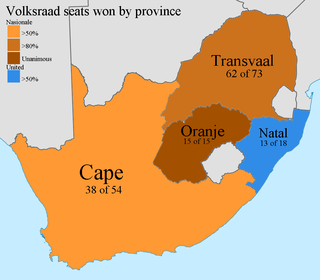
Hendrik Frensch Verwoerd, also known as H. F. Verwoerd, was a South African politician, scholar, and newspaper editor who was Prime Minister of South Africa and is commonly regarded as the architect of apartheid and nicknamed the "father of apartheid". Verwoerd played a significant role in socially engineering apartheid, the country's system of institutionalized racial segregation and white supremacy, and implementing its policies, as Minister of Native Affairs (1950–1958) and then as prime minister (1958–1966). Furthermore, Verwoerd played a vital role in helping the far-right National Party come to power in 1948, serving as their political strategist and propagandist, becoming party leader upon his premiership. He was the Union of South Africa's last prime minister, from 1958 to 1961, when he proclaimed the founding of the Republic of South Africa, remaining its prime minister until his assassination in 1966.

The Parliament of the Republic of South Africa is South Africa's legislature; under the present Constitution of South Africa, the bicameral Parliament comprises a National Assembly and a National Council of Provinces. The current twenty-seventh Parliament was first convened on 22 May 2019.

The National Party, also known as the Nationalist Party, was a political party in South Africa from 1914 to 1997, which was responsible for the implementation and much of the deconstruction of apartheid rule. The party was an Afrikaner ethnic nationalist party, which initially promoted the interests of Afrikaners but later became a stalwart promoter and enactor of white supremacy, for which it is best known. It first became the governing party of the country in 1924. It merged with its rival, the SAP, during the Great Depression, and a splinter faction became the official opposition during World War II and returned to power. With the National Party governing South Africa from 4 June 1948 until 9 May 1994, the country for the bulk of this time was only a de jure or partial democracy, as from 1958 onwards non-white people were barred from voting. In 1990, it began to style itself as simply a South African civic nationalist party, and after the fall of apartheid in 1994, attempted to become a moderate conservative one. The party's reputation was damaged irreparably by perpetrating apartheid, and it rebranded itself as the New National Party in 1997 before eventually dissolving in 2005.
Elections in South Africa are held for the National Assembly, provincial legislatures and municipal councils. Elections follow a five-year cycle, with national and provincial elections held simultaneously and municipal elections held two years later. The electoral system is based on party-list proportional representation, which means that parties are represented in proportion to their electoral support. For municipal councils there is a mixed-member system in which wards elect individual councillors alongside those named from party lists.
The Senate was the upper house of the Parliament of South Africa between 1910 and its abolition from 1 January 1981, and between 1994 and 1997.

The United National South West Party was a political party in South West Africa, the local counterpart of the South African United Party but founded eight years earlier and merged into the latter in 1971. It was formed through a merger of National Party of South West Africa and the South West Party, in order to counter the influence of the German League in South West Africa. The first congress of UNSWP was held in Windhoek on 1–2 April 1927.

General elections were held in South Africa on 15 September 1910 to elect the 121 members of the House of Assembly. They were the first general election after the Union of South Africa was created on 31 May 1910.

General elections were held in South Africa on 17 June 1924, electing 135 members of the House of Assembly. Considered a realigning election, rising discontent with the government of Jan Smuts led to the defeat of his government by a coalition of the pro-Afrikaner National Party and the South African Labour Party, a socialist party representing the interests of the white proletariat.

General elections were held in South Africa on 26 May 1948. They represented a turning point in the country's history, as despite receiving just under half of the votes cast, the United Party and its leader, incumbent Prime Minister Jan Smuts, were ousted by the Herenigde Nasionale Party (HNP) led by D. F. Malan, a Dutch Reformed cleric.

General elections were held in South Africa on 18 October 1961. They were the first general elections after South Africa became a republic following the 1960 South African referendum. The National Party under H. F. Verwoerd won a majority in the House of Assembly.

General elections were held in South Africa on 16 April 1958. The result was a victory for the National Party, now under the leadership of J. G. Strijdom after the retirement of D. F. Malan in 1954. The opposition United Party campaigned for the first time under De Villiers Graaff, who would remain party leader for two decades.

General elections were held in South Africa on 30 March 1966. The result was another comprehensive victory for the National Party under H. F. Verwoerd.

General elections were held in South Africa on 17 May 1933 to elect the 150 members of the House of Assembly. The National Party won half the seats in the House, but the coalition with the South African Party continued.

General elections were held in South Africa on 18 May 1938 to elect the 150 members of the House of Assembly. The United Party won an absolute majority.

General elections were held in South Africa on 7 July 1943 to elect the 150 members of the House of Assembly. The United Party of Jan Smuts won an absolute majority.

The South African Labour Party, was a South African political party formed in March 1910 in the newly created Union of South Africa following discussions between trade unions, the Transvaal Independent Labour Party, and the Natal Labour Party. It was a professedly democratic socialist party representing the interests of the white working class.

The House of Assembly was the lower house of the Parliament of South Africa from 1910 to 1981, the sole parliamentary chamber between 1981 and 1984, and latterly the white representative house of the Tricameral Parliament from 1984 to 1994, when it was replaced by the current National Assembly. Throughout its history, it was exclusively constituted of white members who were elected to office predominantly by white citizens, though until 1960 and 1970, respectively, some Black Africans and Coloureds in the Cape Province voted under a restricted form of suffrage.
The Cape Provincial Council was the provincial council of the Cape Province of South Africa. It was created by the South Africa Act 1909, with effect from the formation of the Union of South Africa on 31 May 1910. The first election to the provincial council took place on 15 September 1910.
The provincial councils were the legislatures of the four original provinces of South Africa. They were created at the foundation of the Union of South Africa in 1910, and abolished in 1986 when they were replaced by a strengthened executive appointed by the State President. The four provincial councils were the Cape Provincial Council, the Natal Provincial Council, the Transvaal Provincial Council and the Orange Free State Provincial Council.
The Coloured vote constitutional crisis, also known as the Coloured vote case, was a constitutional crisis that occurred in the Union of South Africa during the 1950s as the result of an attempt by the Nationalist government to remove coloured voters in the Union's Cape Province from the common voters' rolls. It developed into a dispute between the judiciary and the other branches of government over the power of Parliament to amend an entrenched clause in the South Africa Act and the power of the Appellate Division to overturn the amendment as unconstitutional. The crisis ended when the government enlarged the Senate and altered its method of election, allowing the amendment to be successfully enacted.




















